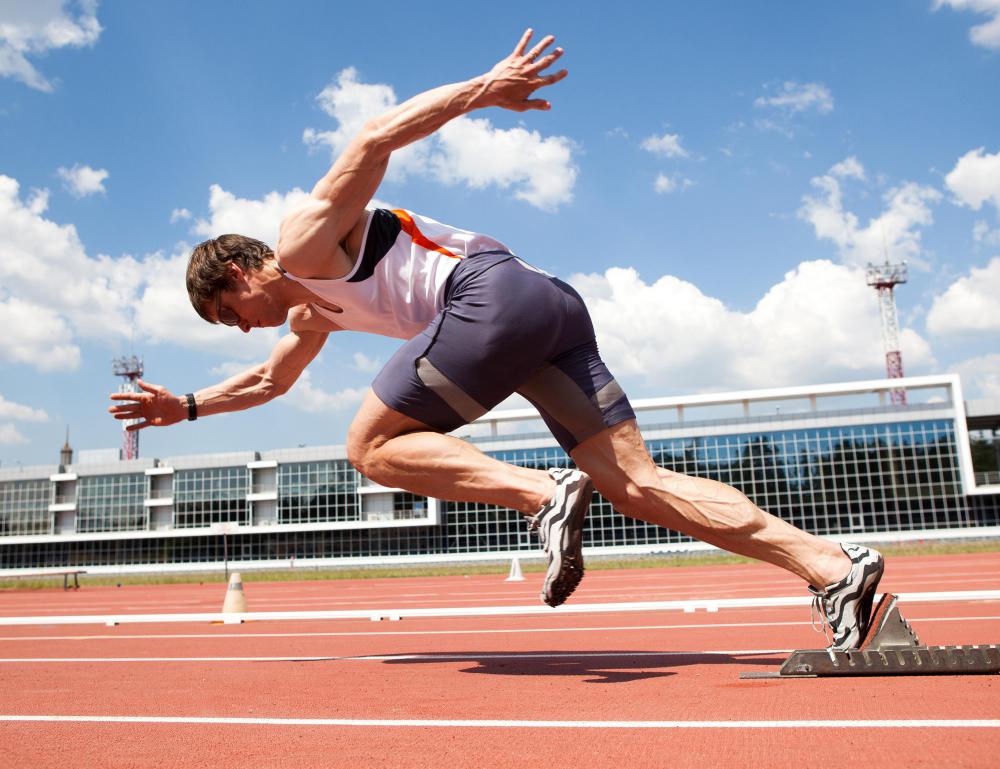At WiseGEEK, we're committed to delivering accurate, trustworthy information. Our expert-authored content is rigorously fact-checked and sourced from credible authorities. Discover how we uphold the highest standards in providing you with reliable knowledge.
What is Dynamic Stretching?
Dynamic stretching is the use of movement to stretch muscles before a workout or athletic competition. It relies on momentum to engage the muscles, rather than holding a stretch at a standstill. These stretches are generally used to prevent muscle strain and to safely allow for swift, powerful movements by athletes.
Athletes who play sports that require sudden movements from a standstill, such as track runners or baseball players, tend to be the most benefited by dynamic stretching. These stretching routines are usually customized for particular sports to mimic movements specific to each individual sport. Movements are designed to prepare the muscles for sudden movements by slightly raising the body temperature. The warmer body temperature usually makes the body better able to handle sudden movement than a cooler, unprepared body.

Dynamic stretching is most often used just before extensive sports-related workouts or competitions. The stretching routines are thought to have both short- and long-term effects. By stretching out muscles through movements similar to ones that occur during athletic competition, the body may become used to the movements and less likely to become injured. Some athletic trainers promote the use of these stretches as a means to prepare the body for the optimal athletic performance over time, by making the body become familiar with the movements. As an athlete’s body gets used to the movements, it may not take as much effort to perform the movements during competition and come more naturally.

There are several types of stretching routines and many are specialized for individual sports or athletes. A common example of a dynamic stretch for the lower body involves alternately raising the knees as high as possible while walking in place. This type of stretch can help prepare leg and back muscles for sprinting activities. A type of dynamic stretch for the upper body involves holding the arms out to the sides of the body and continuously swinging them in circles for approximately 30 seconds to stretch out arms, shoulder, and lower back muscles for upper body movement like throwing or swinging during competition.

Dynamic stretches are often confused with another type of stretching routines used by athletic trainers called static stretching. Static stretching, or holding a particular stretch for a short period, has also been commonly used for athletic warm-up routines. Common examples of static stretching including bending over and touching the toes, or alternately stretching each arm diagonally across the body. Static stretching is thought to be not as effective as dynamic stretching at loosening muscles for swift movements, so it is generally not recommended to athletes prior to competition. It is prescribed more often after workouts to increase long-term flexibility.
AS FEATURED ON:
AS FEATURED ON:














Discussion Comments
@KoiwiGal - Remember that this only applies to cardio or strength workouts. You can still do static stretching for flexibility based workouts, and actually incorporate it into the workout. Although dynamic stretching might be the better option there as well, since it has a more vigorous movement and so it burns more calories.
I guess a martial arts class is basically all made up of dynamic stretching and kicking and moves like that and they are supposed to be really good for you.
@croydon - Yeah I can definitely remember people at the gym encouraging me to stretch before and after the workout. I guess on an intuitive level it kind of makes sense, but it doesn't surprise me that it was wrong. They seem to change their minds about what's right and what's wrong in exercise every decade or so.
The other difference between static and dynamic stretching is that the dynamic stretching makes you feel like you're ready to go, while static stretching always made me want to slow down and stop. So I guess that works on an intuitive level as well.
I always thought that you were supposed to do a mix of static stretching and dynamic stretching before a workout, but apparently you should only do a few dynamic stretches. I went on a sports science binge a few years ago and read everything I could get my hands on about the subject. And all the latest research seems to indicate that static stretching can actually increase your chance of injury while you're exercising.
Warming up, like jogging on the spot, or dynamic stretching exercises, will prepare your muscles for a workout. But static stretching just loosens them, which means they are at risk of over-stretching while you're working out.
It's actually a big surprise because I would have thought this would have been studied before now. Apparently it's only a recent finding.
Post your comments